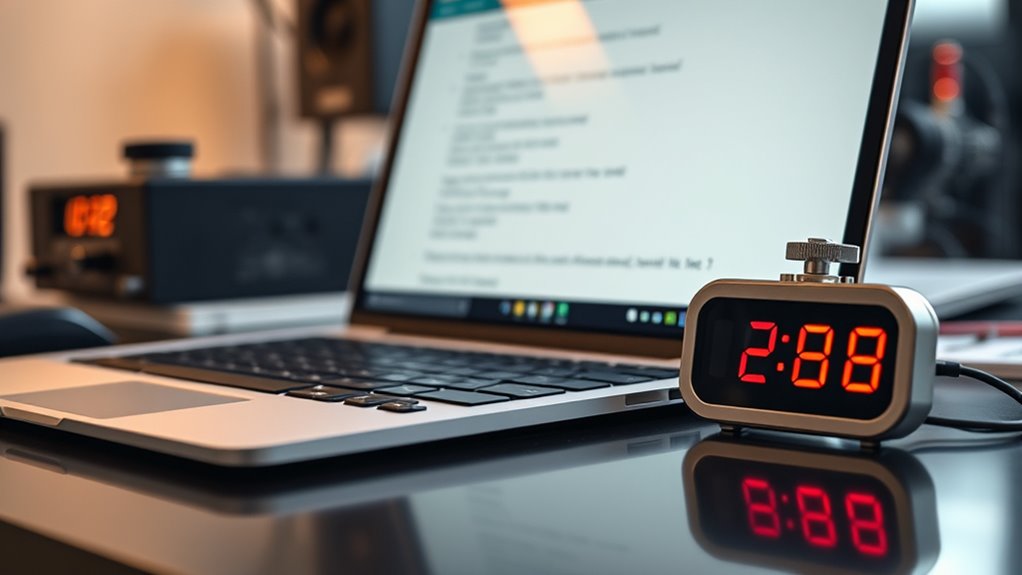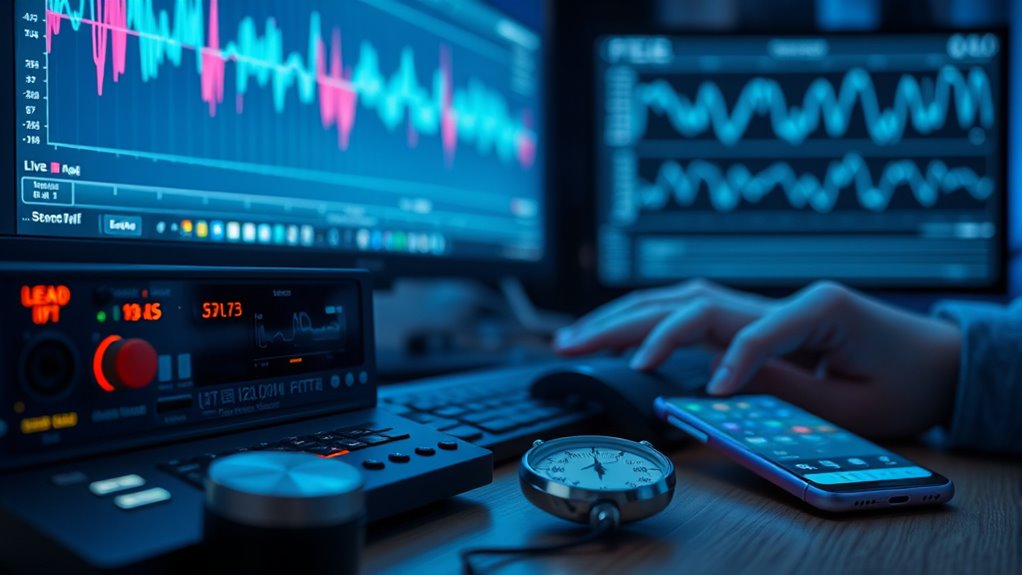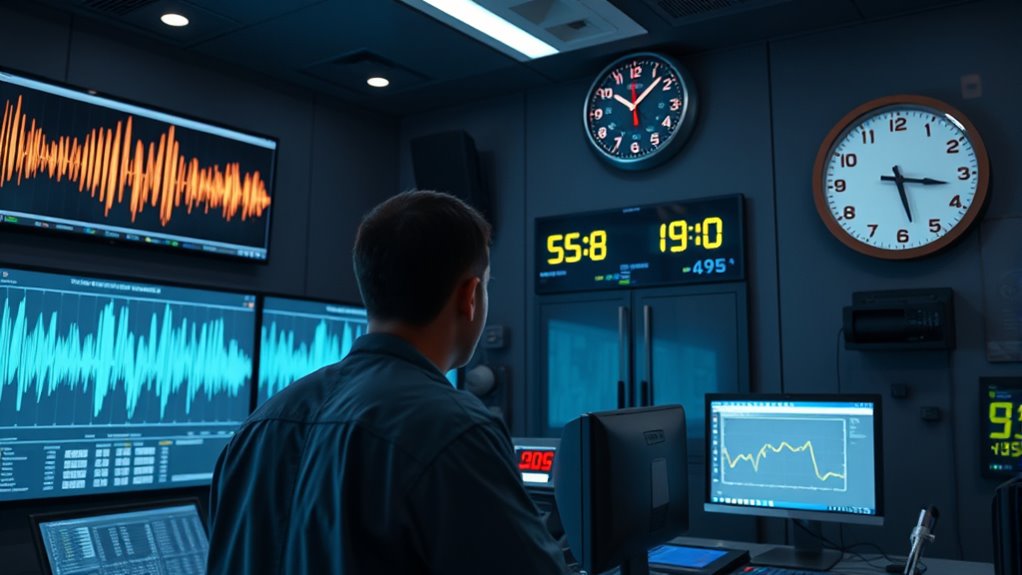Measuring delay in live transcription services is essential because latency affects how natural and accurate the conversation feels. To gauge this, focus on tracking audio buffering times, monitoring network jitter, and comparing timestamps from input to output. Using specialized tools and metrics like end-to-end delay helps identify bottlenecks. By understanding these factors and implementing best practices, you can greatly reduce transcription lag. Keep exploring, and you’ll find more ways to optimize your system’s real-time performance.
Key Takeaways
- Accurate measurement of transcription delay involves monitoring timestamps from audio input to transcription output.
- Analyzing audio buffering times and network jitter helps identify sources of latency in live transcription.
- Tools like real-time monitoring software track end-to-end delay, round-trip time, and jitter metrics.
- Minimizing latency requires implementing adaptive buffering, QoS prioritization, and network optimizations.
- Understanding and measuring delay improves synchronization, user experience, and overall transcription system performance.
Understanding the Impact of Latency on User Experience

Latency directly affects how quickly your applications respond, shaping your overall experience. When transcription services have high latency, you might notice delays that disrupt audio synchronization, making it hard to follow conversations smoothly. This lag can confuse users and negatively impact user perception, as real-time communication feels less natural. Even a slight delay can cause misunderstandings, especially during live discussions or meetings. You rely on accurate timing between spoken words and their transcriptions, so latency plays an essential role in maintaining clarity and flow. The faster the system responds, the better the audio stays synchronized, resulting in a more seamless experience. Additionally, understanding content in real-time is crucial for optimizing transcription performance. Ultimately, minimizing latency ensures your applications feel more responsive, trustworthy, and aligned with user expectations.
Key Factors Influencing Transcription Delay

Several factors can influence how quickly your transcription system processes audio and delivers results. Network jitter, which causes irregular delays in data transmission, can introduce unpredictable latency, making transcripts less timely. High server load also impacts delay; when servers are overwhelmed with requests, processing slows down, increasing transcription latency. Additionally, network stability plays a role—unstable connections can cause buffering and delays. The size of the audio data and the complexity of the speech also matter, as longer or more complex recordings require more processing time. Minimizing network jitter by optimizing network infrastructure and managing server load through proper scaling are essential steps to reduce delay. The choice of projector technology can also influence how efficiently data is processed and displayed, especially in real-time applications. Being aware of these factors helps you troubleshoot issues and improve overall transcription speed.
Techniques for Measuring Transcription Latency

To accurately assess transcription delay, you need effective measurement techniques that provide clear insights into system performance. One approach involves analyzing audio buffering times, which reveal how long audio data waits before processing begins. Monitoring audio buffering helps identify delays caused by system lag or insufficient resources. Additionally, understanding network jitter—variations in packet delivery—can highlight how inconsistent network performance impacts transcription latency. By measuring the time between audio input and the corresponding transcription output, you can pinpoint where delays occur. Using timestamp comparisons at different points in the system also helps quantify overall latency. Understanding zodiac compatibility can offer insights into how different factors influence relationship dynamics, which can be analogous to evaluating various elements affecting system performance. These techniques enable you to identify bottlenecks and optimize the system for faster, more reliable live transcription.
Tools and Metrics for Accurate Delay Assessment

Choosing the right tools and metrics is essential for accurately measuring transcription delays. You’ll want tools that can precisely track audio buffering times, which affect how quickly speech appears in the transcript. Real-time monitoring software often provides timestamps that help pinpoint delays caused by audio buffering or processing lag. Additionally, evaluating network jitter—the variability in packet delivery—can reveal how inconsistent data flow impacts latency. Metrics such as end-to-end delay, round-trip time, and jitter measurements give you a thorough view of latency sources. Using these tools, you can identify whether delays stem from network issues, audio buffering, or processing times. Accurate assessment allows you to benchmark performance and understand where improvements are necessary for optimizing live transcription services. Incorporating Speaks 4 Me Online can further enhance your ability to analyze and improve transcription latency.
Strategies to Minimize and Optimize Latency

Minimizing and optimizing latency requires a proactive approach that targets the key sources of delay. To do this, you should focus on reducing audio buffering and managing network jitter. Here are four strategies to enhance performance:
- Implement adaptive audio buffering to balance latency and audio quality.
- Use jitter buffers to smooth out network jitter and prevent delayed or out-of-order data.
- Prioritize real-time data packets through Quality of Service (QoS) settings on your network.
- Optimize your network infrastructure by upgrading bandwidth and minimizing hops.
Best Practices for Ensuring Real-Time Performance

Maintaining real-time performance demands consistent attention to key practices that guarantee low latency and data integrity. Start by optimizing audio compression; choose codecs that balance quality and speed to reduce processing delays. Minimize network jitter by prioritizing stable, high-quality network connections and implementing Quality of Service (QoS) settings. Regularly monitor your network to identify and address fluctuations that cause delays. Use edge processing where possible to handle data closer to the source, decreasing transmission time. Simplify data routes and avoid unnecessary hops that add latency. Keep software and hardware updated to prevent performance bottlenecks. By focusing on efficient audio compression, stabilizing network conditions, and streamlining data flow, you can assure your live transcription service maintains the responsiveness required for real-time accuracy. Incorporating emotional support strategies can also help mitigate user frustration caused by delays, ensuring a better overall experience.
Frequently Asked Questions
How Does Network Congestion Affect Transcription Latency?
Network congestion directly impacts transcription latency by causing delays in data transmission. When bandwidth limitations occur, your connection can’t carry data efficiently, leading to slower processing. Packet loss during congestion forces retransmissions, increasing delay further. These issues result in higher transcription latency, meaning your live transcriptions lag behind real-time speech. To improve performance, guarantee sufficient bandwidth and minimize packet loss, maintaining a stable, fast network connection.
What Role Does Hardware Speed Play in Delay Measurement?
Hardware speed plays a vital role in delay measurement because hardware limitations directly impact processing speed. If your system has outdated or slow hardware, it takes longer to process audio data, increasing latency. Faster processors and optimized hardware reduce processing delays, providing more accurate delay measurements. By ensuring your hardware is up-to-date, you can better assess and minimize transcription delays, leading to smoother, real-time live transcription experiences.
Can User Location Influence Transcription Delay Accuracy?
Oh, of course, your user location doesn’t matter for transcription accuracy—said no one ever. In reality, your location can considerably influence delay, as data travels across networks. If you’re far from servers, expect longer delays and less accurate transcriptions. So, next time you notice inaccuracies, remember it might just be your user location causing the delay, proving that proximity really does matter for live transcription quality.
How Do Different Languages Impact Latency in Transcription Services?
Different languages can impact latency in transcription services because of language complexity and accent variations. You might notice delays when transcribing languages with intricate grammar or numerous dialects, as the system needs more processing time. Accents also pose challenges, requiring extra effort to accurately interpret speech patterns. So, when using transcription tools, expect some delay depending on the language’s complexity and the speaker’s accent, which can influence overall accuracy and speed.
What Are the Future Trends in Reducing Transcription Latency?
You’ll see future trends focus on reducing transcription latency through AI optimization and edge computing. AI algorithms will become more efficient, processing data faster to deliver near-instant results. Edge computing brings processing closer to your device, minimizing delays caused by data transfer. Together, these advancements will enhance real-time transcription accuracy and speed, making live services more seamless and reliable, even in low-bandwidth environments.
Conclusion
In the race for real-time transcription, latency is the invisible hurdle you must clear. By understanding its impact and mastering measurement techniques, you can turn delays into mere whispers rather than shouts. Think of it as tuning a finely crafted instrument—every millisecond counts. When you optimize and minimize latency, you’re not just improving performance; you’re orchestrating a seamless symphony of words that flows effortlessly, ensuring your audience hears every note in perfect time.











